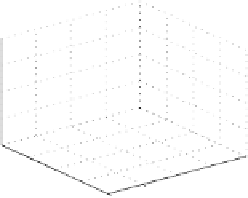Geoscience Reference
In-Depth Information
224
Multiscale Geomechanics
1
10
0.5
5
0
0
0. 5
5
1
10
1
1
0.5
1
0.5
1
0.5
0.5
0
0
0
0
0. 5
0. 5
0. 5
0. 5
1
1
1
1
λ
1
> 0,λ
2
>0,λ
3
>0
λ
1
>0,λ
2
>0,λ
3
=0
λ
1
>0,λ
2
>0,λ
3
<0 λ
1
>0,λ
2
=0,λ
3
<0
Figure 8.1.
Solutions of equation:
λ
1
X
2
+ λ
2
Y
2
+ λ
3
Z
2
=0
.The four complementary
solutions with opposite signs of eigenvalues are the same, but the sign of second-order work is
geometrically also complementary.
λ
1
> 0,λ
2
>0,λ
3
<0
give positive second-order work
outside the cone and negative inside while
λ
1
< 0,λ
2
<0,λ
3
>0
give positive second-order
work outside the cone and positive inside
with
λ
1
,λ
2
,λ
3
being the eigenvalues of a quadratic form matrix. Figure 8.1 illustrates
the different mathematical solutions. It should be noted that the solutions displayed in
the right column (line and planes intersection) are never reached numerically. In fact,
chances are poor for obtaining a numerically exactly null value of the eigenvalues.
Nevertheless, a solution given by a straight line is almost reached, if
λ
3
is very low, the
elliptical cone is almost closed. On the other hand, for the solution given by the two
planes, even if
λ
2
is very low, we retrieve instantly an elliptical cone.
Given these results, we understand that the second-order work condition refers to
the direction of the loading rate. A material point which admits none of the solutions
of equation [8.8] is stable without other conditions. Conversely, the material point is
potentially unstable: stability is conditioned by the loading path direction. So, it is
possible to define the bifurcation domain limit as the set of stress states which admit
a unique unstable loading direction. Assuming that all eigenvalues are strictly positive
at the initial virgin state and that they evolve in a continuous manner with the loading

































Search WWH ::

Custom Search